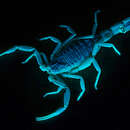pms
nòm ant ël fil


Leiurus je rod velkých pouštních štírů se silným jedem. Donedávna byl pokládán za monotypický s jediným druhem L. quinquestriatus, ale roku 2002 byl popsán L. Jordanensis, roku 2006 L. savanicola a v roce 2007 L.nasheri.
Leiurus je rod velkých pouštních štírů se silným jedem. Donedávna byl pokládán za monotypický s jediným druhem L. quinquestriatus, ale roku 2002 byl popsán L. Jordanensis, roku 2006 L. savanicola a v roce 2007 L.nasheri.
Leiurus is a genus of scorpion of the family Buthidae. The most common species, L. quinquestriatus, is also known under the common name Deathstalker. It is distributed widely across North Africa and the Middle East, including the western and southern Arabian Peninsula and southeastern Turkey. At least one species occurs in West Africa (northern Cameroon).
The genus was introduced in 1828 by C.G. Ehrenberg (in Hemprich & Ehrenberg 1828),[1] originally as a subgenus of the genus Androctonus. It was finally elevated to genus rank by M. Vachon in 1949.[2] The genus was long considered to be monotypic, containing a single species, L. quinquestriatus, but research since 2002 has shown that there are indeed several species.[3]
Currently twenty species are recognized within this genus.[4]
Members of Leiurus are generally moderately sized scorpions that show a typical buthid habitus with gracile pedipalp chelae and a slender metasoma. The vesicle is bulbous and proportionally large in some species. The cephalothorax and mesosoma shows distinct granulation. Characteristically the tergites of the mesosoma bear five distinct, longitudinal carinae (ridges). The base color is generally yellow with brown to blackish areas extending over various parts of the animal, depending on species.[21]
The venom of L. quinquestriatus is among the most potent scorpion toxins. It severely affects the cardiac and pulmonary systems. Human fatalities, often children, have been confirmed by clinical reports.[22] The median lethal dose of venom (LD50) for this species was measured at 0.16 - 0.50 mg/kgmice.[23]
The toxicity of the other species is also potentially high to life-threatening, but reliable data are currently not available.
Most species live in semi-arid to arid regions, including the Sahara and Arabian deserts. At least one species occurs in savannah environment. Sparsely vegetated and sandy or rocky substrates are preferred. The scorpions live in shallow burrows in sand or beneath rocks.
Members of the genus Leiurus are often bred in captivity and traded. Due to their extreme toxicity, keeping these species is strictly recommended to only very experienced and/or professionally trained people.
{{cite journal}}: CS1 maint: multiple names: authors list (link) {{cite journal}}: CS1 maint: multiple names: authors list (link)  Leiurus jordanensis adult female in captivity
Leiurus jordanensis adult female in captivity Leiurus is a genus of scorpion of the family Buthidae. The most common species, L. quinquestriatus, is also known under the common name Deathstalker. It is distributed widely across North Africa and the Middle East, including the western and southern Arabian Peninsula and southeastern Turkey. At least one species occurs in West Africa (northern Cameroon).
Leiurus est un genre de scorpions de la famille des Buthidae.
Les espèces de ce genre se rencontrent dans le Nord de l'Afrique et au Moyen-Orient[1].
Selon The Scorpion Files (07/05/2021)[2] :
Leiurus Ehrenberg, 1928 è un genere di scorpione della famiglia dei Butidi.[1]
Comprende le seguenti specie:[1]
Leiurus is een monotypisch geslacht van schorpioenen uit de familie van de Buthidae.
Leiurus is een monotypisch geslacht van schorpioenen uit de familie van de Buthidae.
Leiurus là một chi bọ cạp trong họ Buthidae. Loài phổ biến nhất của chi này, Leiurus quinquestriatus, thường được biết đến với tên gọi Deathstalker (Tiếng gọi tử thần). Chúng được tìm thấy chủ yếu ở các vùng Bắc Phi và Trung Đông.
Leiurus là một chi bọ cạp trong họ Buthidae. Loài phổ biến nhất của chi này, Leiurus quinquestriatus, thường được biết đến với tên gọi Deathstalker (Tiếng gọi tử thần). Chúng được tìm thấy chủ yếu ở các vùng Bắc Phi và Trung Đông.